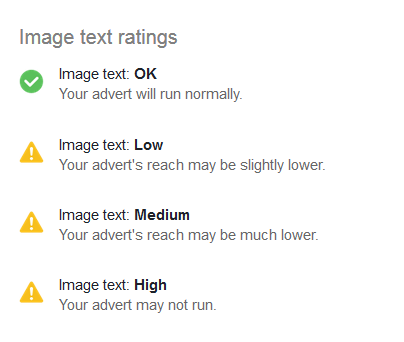How many times have you created an amazing Facebook add only for the powers that be to reject it for violating the 20% text rule? Yes, we’ve all been there at least once!
Earlier this year Facebook removed the 20% text rule in the UK market for beta testing, and just this month (June, 2016) removed the 20% text rule for all publishers.
Does this mean you can use 90% of text in your ads? Yes.
Does it also mean ads that are 90% text receive the same reach? No.
In this article I’ll go over the old rule, the new rule and what publishers are experiencing right now.
The Old Rule
The 20% text rule before was enforced using Facebook’s 5×5 text overlay tool. If your ad covered 3 or more squares with text, your ad was rejected. You could find out whether your ad was above the 20% by using the text overlay tool here.
However, this method wasn’t all that useful as publishers realized if they moved the placement of their words to exactly fit the boxes, their ads would be approved whereas before they were rejected.
This ended up causing a lot of confusion for advertisers on what was and wasn’t allowed.
Why Facebook Made the change
What ads you can and cannot run on Facebook is not always black and white, this was especially true with the 20% rule and it’s why Facebook decided to change it.
Afsheen Ali, Product Marketing Manager at Facebook went on record to say the reason for the change was to reduce confusion for publishers who were unsure why their ad copies were being rejected.
The old method to measure text wasn’t accurate and easy to exploit.
So what’s the new rule going forward?
The New 20% Text rule
Okay so let’s get one thing clear, while the 20% text rule is now gone, if your ads contain more than 20% text it may reach fewer people and potentially cost you more in ad spend.
Facebook will no longer use the 5×5 overlay tool to decide whether to approve or reject, instead each image will be placed in one of four categories:

OK – There is less than 20% in the ad copy and it will not be affected by reach or cost.

Low – There is some text in the copy and your ad’s reach may be slightly limited.
Medium – Your ad’s reach being limited.
High – Your ad is using too much text and you may not reach any of your audience. Facebook may not necessarily reject your ad but it won’t be shown.

These rules are applied to most ad copies but do not apply if you’re promoting:
- Movie posters
- Info-graphics
- Legal text
- Posters for events
- Product images
- Music album and book covers
In a nutshell, if your ads contain more than 20% text (low, medium or high) you may be charged a higher amount per action and reduce the amount of reach, but your ads will not be rejected like before.
With the old rule, you’d simply need to use the Facebook overlay tool to find out whether your ad contains more or less than 20% text.
Facebook has said it will be updating its grid tool very soon to help publishers determine which of the 4 categories their ads now fall into.
What Should Publishers Be Doing Now?
While the 20% text rule has been removed, you will face problems with your ad’s serviceability if you decide to exceed that threshold.
Should you start using more text in your ad copies? There is no simple answer until you test and see what yields a better conversion rate.
Text based ads may work better for businesses who offer a service to call out the prospect as they don’t have a physical product to show, but each business’s audience differs so much that you won’t know the correct route to take without testing.
Current Feedback From New Text Changes
So the 20% text rule on Facebook has been removed but it may take a few weeks before you can see the new options on your Ad account. Early reports of these new changes are mixed, some publishers are saying older ads that previously passed the 20% text rule are now considered to be ‘medium’ text and are costing them more and with impressions decreasing dramatically.
Others are happy with the changes because it provides them more clarity on how they can use text in their ads. One things for sure, Facebook will need to tweak its overlay tool a bit more because some ads that are full of text are being passed as ‘OK’ when they are clearly full of text:

As with any new update or change there will always be teething problems, I fully expect Facebook to revamp and better optimize their tool to make every publisher’s job easier.
What are your thoughts on the new Facebook ad text changes?